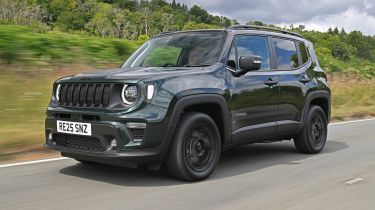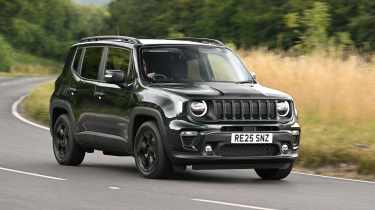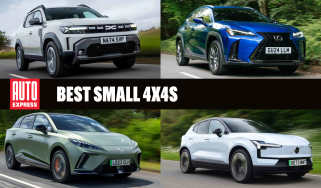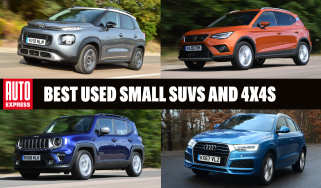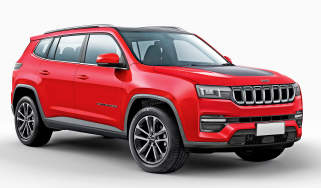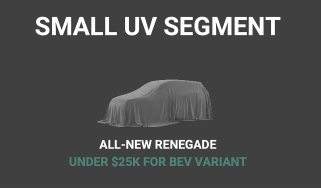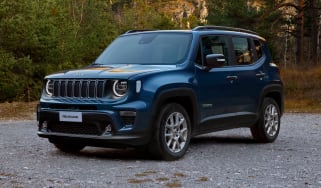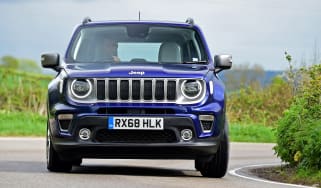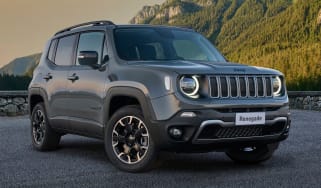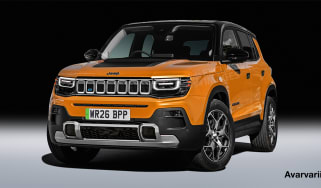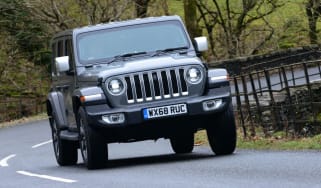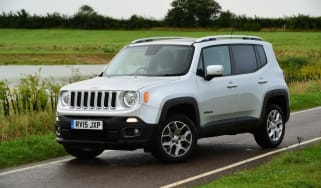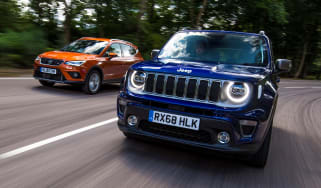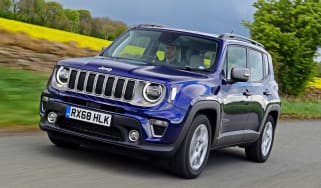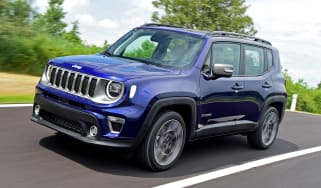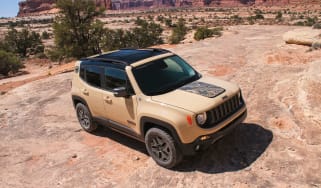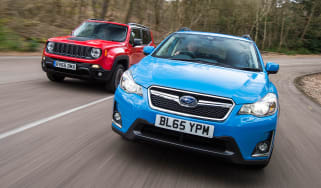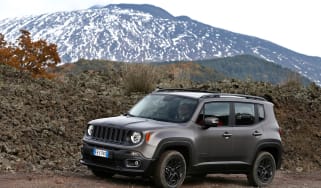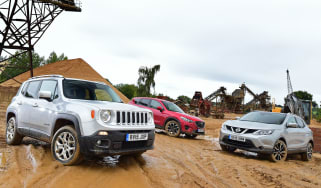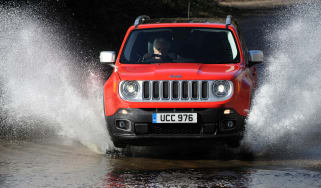Jeep Renegade review
The Jeep Renegade small SUV really feels its age, and we believe rivals beat it in most areas

Our opinion on the Jeep Renegade
The Jeep Renegade is a car that feels as if it’s been on sale for just a little bit too long. This small SUV wasn’t a class leader when it was launched in 2014, and while the most recent versions are loaded with kit, the Renegade falls behind its rivals in most areas. The plug-in hybrid model doesn’t offer the cost benefits to attract business users away from competitors, while the lower powered hybrid is disappointing, too. At least the Renegade maintains Jeep’s reputation for building models that can head off the beaten path, with genuine off-road ability that’s lacking from all of its small-SUV rivals.
About the Jeep Renegade
Few cars are as long-lived as the Jeep Renegade. It was the company’s smallest SUV when production first started in 2014 – it’s now been superseded by the Jeep Avenger – and more than a decade later, it’s still going. We’d say it’s still going strong, but it has never really excelled; rivals have long had the measure of it in most respects.
In terms of size, the Renegade sat somewhere between the compact and small SUV sectors when it was launched, but as time has progressed and new models have arrived, its dimensions mean it’s more of a small SUV these days. Still, its boxy, upright shape looks chunky and creates a decent amount of space inside, while details such as the ‘halo’ daytime running lights, X-shaped tail-lights and Jeep’s trademark seven-bar grille mean the Renegade isn’t without appeal.
Used - available now

2023 Jeep
Renegade
30,723 milesAutomaticPetrol1.3L
Cash £17,049
2021 Jeep
Renegade
35,986 milesAutomaticPetrol1.3L
Cash £14,900
2021 Jeep
Renegade
33,827 milesManualPetrol1.0L
Cash £10,900
2018 Jeep
Renegade
57,000 milesAutomaticPetrol1.4L
Cash £10,995Trim levels have changed over time, and inspirational Jeep names such as Longitude, Overland, Trailhawk and Limited have come and gone, while special editions such as the Night Eagle have also graced the price lists. Now that the Renegade is approaching the end of production, there are standard Summit and well equipped North Star variants on offer, with the latter launched to celebrate a million Renegades and Compasses sold in Europe.
Petrol and diesel variants were offered early on, but today there are just hybrid and plug-in derivatives, with the latter badged 4xe. Given that the Renegade has been around since before parent companies Fiat Chrysler and Peugeot Citroen merged to create Stellantis, it uses older tech than many other models in the empire’s line-up, and they’re not the most efficient powertrains around. Still, automatic gearboxes are standard across the board, while four-wheel drive comes as part of the PHEV powertrain, so the Renegade meets Jeep’s brief as a maker of go-anywhere passenger vehicles.
Jeep Renegade prices and latest deals
There’s a limited model line-up on offer as a new car, and the Jeep Renegade has list prices that start from around £33,000 for the special-edition North Star variant, while the 4xe plug-in hybrid is around £38,600 and only comes in North Star spec. However, since the Renegade has been around for more than a decade there’s a wide range of prices offered on the used market, and our Buy A Car service will help you to find one to suit your budget.
Performance & driving experience
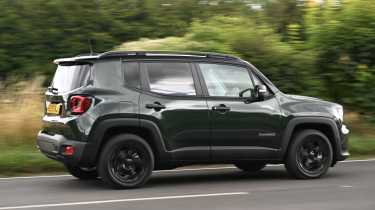
Pros |
|
Cons |
|
The Renegade uses the same platform as the Fiat 500X – which can trace its roots to the Alfa Romeo Giulietta – and it was one of the first products of the partnership between Fiat and Chrysler. It first arrived at the end of 2014 for the 2015 model year, while it was given a fairly comprehensive update in 2018 and minor tweaks have been made to keep it up to date with emissions legislation, which is why you just get hybrid models today.
Performance, 0-60mph acceleration and top speed
Overall the Renegade is feeling its age in terms of driving experience. It’s not as sharp as newer rivals, but at least its modest wheel sizes mean that the ride is acceptably comfortable. It’s perfectly fine to drive, just don’t expect much from it in terms of fun or responsiveness.
Petrol power in the Renegade range has included 1.0-litre three-cylinder and 1.3-litre four-cylinder engines, but today there are two powertrain options available that both have hybrid drive as part of their make-up.
First there’s the 1.5 e-Hybrid, which runs a special compression cycle petrol engine to boost efficiency and features a small battery for electrical assistance. This model is front-wheel drive and comes with a seven-speed automatic gearbox as standard.
While the 4xe PHEV variant packs a 237bhp punch, it’s not the smoothest of hybrid units. It’s an older Fiat-Chrysler developed powertrain, which offers inconsistent responses as the electronics decide whether you need electric drive or petrol power. Once the battery is exhausted, the response is even flatter, and we’d recommend trying to charge the battery as often as possible to make the powertrain feel smoother.
| Model | Power | 0-62mph | Top speed |
| Renegade 1.5 E-Hybrid | 128bhp | 9.7 seconds | 119mph |
| Renegade 1.3 4xe PHEV | 237bhp | 7.1 seconds | 124mph |
Town driving, visibility and parking
The Renegade’s upright shape, large windows and high seating position mean that there’s a decent view of your surroundings, while a reversing camera, front and rear parking sensors and rear cross-traffic alert help to mitigate against blind spots.
In the PHEV, the small 11.4kWh battery only has an official range of 30 miles, so you don’t have to travel very far before the petrol engine kicks in. When the motor does fire up, it can become pretty coarse, especially under hard acceleration. There’s plenty of urge once you’re moving, but it’s not the most pleasant experience.
Country road driving and handling
The rest of the drive isn’t a patch on newer rivals, either. There’s good grip and the ride is reasonable on those small wheels, but body roll is pronounced and the steering offers little in the way of feedback, too. You wouldn’t want to take the Renegade out just for the fun of it.
However, choose a four-wheel-drive version, and you’ll have more off-road capability than you’re ever likely to need, as well as additional grip in slippery conditions. It gives the US firm a unique selling point that no other rival at this price point can compete with, even when cars such as the Renegade are past their best.
Motorway driving and long-distance comfort
Because the Renegade’s hybrid systems are older set-ups, they rely more on the petrol part of the powertrain at higher speeds. This results in plenty of engine noise, which spoils overall refinement. At least the ride stays comfortable on those relatively small wheels.
"Having spent a number of motorway miles behind the wheel of a Renegade, I found its positives and negatives certainly came into focus. I found the ride was reasonable, but the battery doesn’t last long, so you’re reliant on the petrol engine most of the time, which harms refinement as well as efficiency." - Dean Gibson, Senior Test Editor
MPG & running costs
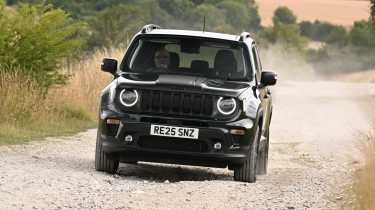
Pros |
|
Cons |
|
The all-hybrid Renegade line-up boosts the car’s fuel economy when compared with the original models, but there are plenty of more efficient rivals available.
You would expect a hybrid powertrain to deliver efficiency, but the Renegade’s older plug-in system doesn’t perform as well as the more modern set-ups found in updated rivals. Official fuel economy is 134.5mpg, which will only be attainable in the real world if you keep the battery charged. However, similarly priced cars such as the Hyundai Kona PHEV and BYD Seal U have figures in the 200-300mpg range under the same test conditions, revealing the limited range that the Renegade offers in comparison.
In addition, the Renegade 4xe has a smaller fuel tank than the e-Hybrid model to make space for the larger plug-in battery. At 36.5 litres it’s nearly 12 litres down, and if you don’t charge the battery when parked, this is going to cut the car’s overall range significantly. Either way, stops are going to be frequent to top up either the battery or the fuel tank.
| Model | MPG | CO2 | Insurance group |
| Renegade 1.5 E-Hybrid | 52.3mpg | 127g/km | 17 |
| Renegade 1.3 4xe PHEV | 134.5mpg | 48g/km | 26 |
Electric range, battery life and charge time
While the battery in the 4xe PHEV is small at 11.4kWh, that does mean it’s quick to top up when compared with a full EV. It can go from flat to fully charged in an hour and 40 minutes when plugged into a 7.4kWh wallbox, but that’s as fast a charging speed as you’ll get, because there are no quicker options available.
| Model | Battery size | Range | Insurance group |
| Renegade 1.3 4xe PHEV | 11.4kWh | 30 miles | 26 |
Insurance groups
The complexity of the plug-in powertrain has a negative effect on insurance group ratings. The e-Hybrid model falls into group 17, but the 4xe is nearly 10 groups higher in 26.
Tax
All versions of the Jeep Renegade fall below the £40,000 luxury car surcharge for road tax, so the 4xe will be a cheaper car to run than many other four-wheel-drive SUVs.
Depreciation
There’s a retained value of around 43 per cent for the e-Hybrid version of the Renegade, which is at the lower end of the spectrum in the small SUV class, but not shocking. However, the 4xe falls to 37 per cent, which is pretty poor. This isn’t the worst performer in the Jeep line-up, though, because the Compass has even less impressive residuals.
Interior, design & technology
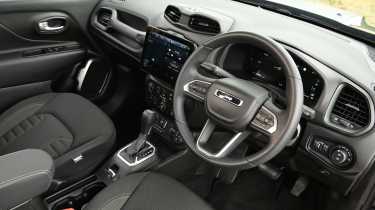
Pros |
|
Cons |
|
The Renegade’s cabin was designed back in the early 2010s, so it looks quite dated today, and features plenty of hard plastics. But since the Renegade is an older car, it also has a lot of physical controls instead of touchscreen functions, which will be a bonus for some people. Some of the controls aren’t that logically laid out, while the fuel filler release on the PHEV model – it’s a safety feature to prevent opening the filler while the car is on charge, to help prevent the risk of fire – looks a bit like an aftermarket addition. As well as the touchscreen and climate controls, a third bank of switches sits beneath the climate settings to change the off-road modes.
Interior and dashboard design
Inside, Jeep squeezes in plenty of character touches. The Jeep ‘face’ of round headlights and seven-slot grille is embossed into the rear-view mirror housing, speaker surrounds and tailgate. The air vent design is apparently inspired by base-jumping equipment, the pod-like central vents by ski goggles, and you even get a mud splatter graphic instead of a red line on the rev counter.
Materials and build quality
Hard plastics are the order of the day, but as with other off-road biased models, the Renegade makes a virtue of this and incorporates it into the design.
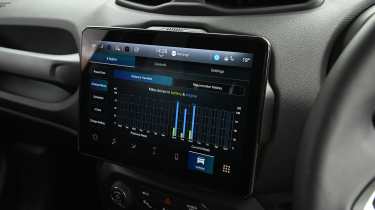
Infotainment, sat-nav and stereo - subhead H3
There’s a modest 10-inch touchscreen inside, while the driver gets a 10.25-inch display ahead of the steering wheel that shows loads of information. The main screen has plenty of functionality, with Bluetooth included alongside Apple CarPlay and Android Auto, allowing you to bypass the native infotainment system if you want.
"I quite like the North Star edition’s upgrades, which are designed first and foremost to deliver decent value for money on the Renegade. This starts with the exterior, where Technogreen metallic paint sits alongside gloss black 17-inch alloys (which look a little small these days) and a glare-reducing matt-black bonnet decal. Subtle badges pick out Polaris and its constellations, while roof rails and LED foglights complete the look." - Dean Gibson, Senior Test Editor
Boot space & practicality
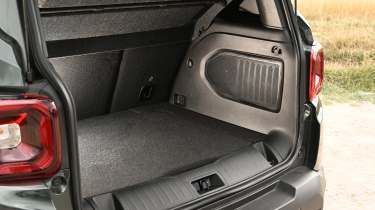
Pros |
|
Cons |
|
One plus point of the Jeep, despite its age, is the amount of space on offer. Those upright, boxy proportions mean there’s plenty of headroom, even with a panoramic roof. Knee space isn’t quite as good, but deep bases mean the rear seats are more supportive than those found in some competitor cars. The boot offers an acceptable amount of space, with 330 litres in the 4xe and 351 litres in the Hybrid; the cube-shaped area is easy to load.
Dimensions and size
The tale of the tape reveals that the Renegade is slightly longer and wider than a Nissan Juke, but is far taller, hence the boxy proportions. But the packaging isn’t great, so boot space, especially, is a little on the small side, especially when choosing the 4xe PHEV.
| Dimensions comparison | |||
| Model | Jeep Renegade | Nissan Juke | Nissan Qashqai |
| Length | 4,236mm | 4,210mm | 4,425mm |
| Width | 1,805mm | 1,800mm | 1,835mm |
| Height | 1,692mm | 1,593mm | 1,625mm |
| Wheelbase | 2,570mm | 2,636mm | 2,665mm |
| Boot space | 330-1,297 litres | 422-1,305 litres | 479-1,422 litres |
Seats & passenger space
The doors open by up to 70 degrees at the front and 80 degrees at the rear, aiding access, while the raised ride height means the Renegade isn’t difficult to climb into. A wide range of seat adjustment means it’s easy to get comfortable at the wheel, too.
While there are three seatbelts in the back, the middle seat is quite narrow and kneeroom is in short supply for all rear passengers. Head and shoulder room is better, though, and Isofix child seat mountings are standard.
Boot space
The Renegade’s boot offers 351 litres of space in the e-Hybrid and 330 litres in the 4xe, or up to 1,297 litres when they’re folded (1,277 litres in the 4xe). This is similar to rivals such as the Nissan Juke and the MINI Countryman – the latter has an impressive 450-litre boot capacity, but only 1,170 litres with the seats folded.
Towing
If you want to tow, the e-Hybrid can haul up to 1,400kg, but disappointingly the more powerful 4xe PHEV can only tow 1,150kg, making the Renegade pretty much a non-starter if you want to pull a caravan.
"The North Star edition comes with a panoramic sunroof, but since the Renegade has such a high roof, it doesn’t have a negative impact on headroom, even for the tallest passengers." - Dean Gibson, Senior Test Editor
Reliability and Safety
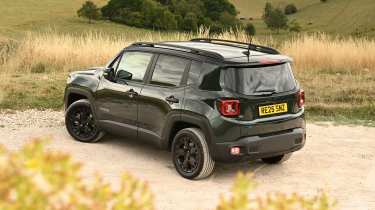
Pros |
|
Cons |
|
Back in 2014, Euro NCAP awarded the Renegade a full five-star rating for safety. However, as a mark of ever-improving standards in this area, Jeep’s small SUV only managed a three-star rating when retested in 2019 under more stringent testing. Since then the test regime has become tougher still, while the Renegade’s rating expired in 2025.
All models benefit from a high-strength steel body construction, a multitude of airbags and other features such as traffic sign recognition, a lane-departure warning system and rollover mitigation that helps to prevent the car tipping over during emergency manoeuvres.
Over time, optional safety kit has been upgraded to standard fit, so systems such as automatic emergency braking, blind-spot warning and rear cross traffic protection will be available on newer models.
| Euro NCAP safety ratings | |
| Euro NCAP safety rating | Three stars (2019, rating expired in 2025) |
| Adult occupant protection | 82% |
| Child occupant protection | 84% |
| Vulnerable road user protection | 55% |
| Safety assist | 58% |
Buying and owning
Best buy: Jeep Renegade 1.5 e-Hybrid North Star
The 4xe is pricey, so we’d only recommend it if you need off-road ability. North Star trim is packed with kit and looks smart, although you’ll find plenty of bargains in the used market via our Buy A Car service.
Jeep Renegade alternatives
Rivals for the Renegade have come and gone, with the most obvious alternative being the now discontinued Fiat 500X that was built in the same factory in Italy. The MINI Countryman has grown in size since the Renegade was originally launched, as have the Toyota C-HR and Honda HR-V. Perhaps the only other small SUV that is nearly as long-lived as the Renegade is the Audi Q2, although prices are higher and there’s no PHEV variant.
Deals on the Jeep Renegade and alternatives
Jeep Renegade pictures
Frequently Asked Questions
In a word, no, but there are certain elements that appeal. Some will like the chunky styling, and if you want a small SUV that can actually tackle off-road terrain, then nothing in the class will be as capable.

